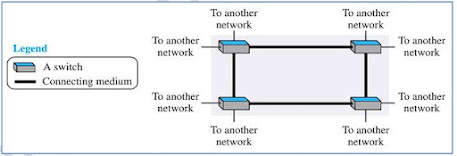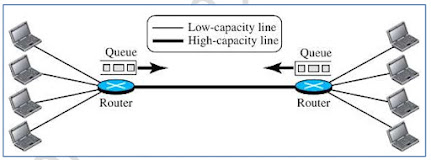Computer network notes, data communication in computer Network, computer network types, network topology ,local area network, wide area network switched network
Network Types ( Geographical coverage)
1. Local Area Network
2. Wide Area Network
3. Switching .
Local Area Network :
- A local area network (LAN) is usually privately owned and connects some hosts in a single office, building, or campus.
- Depending on the needs of an organization, a LAN can be as simple as two PCs and a printer in someone’s home office, or it can extend throughout a company and include audio and video devices .
- Each host in a LAN has an identifier, an address that uniquely defines the host in the LAN.
- A packet sent by a host to another host carries both the source host’s and the destination host’s addresses.
- in the past, all hosts in a network were connected through a common cable, which meant that a packet sent from one host to another was received by all hosts. The intended recipient kept the packet; the others dropped the packet.
- Today, most LANs use a smart connecting switch Today, most LANs use a , which is able to recognize the destination address of the packet and guide the packet to its destination without sending it to all other hosts.
- The switch improve the traffic in the LAN and allows more than one pair to communicate with each other at the same time if there is no common source and destination among them.
- Note that the above definition of a LAN does not define the minimum or maximum number of hosts in a LAN. Figure shows a LAN using either a common cable or a switch.
Wide Area Network(WAN) :
- A wide area network (WAN) is also an interconnection of devices capable of communication .
- However, there are some differences between a LAN and a WAN. A LAN is normally limited in size, spanning an office, a building, or a compose a WAN has a wider geographical span spanning a town, a state, a country, or even the world .
- A LAN interconnects hosts; a WAN interconnects connecting devices such as switches, routers, or modems
- A LAN is normally privately owned by the organization that uses it; a WAN is normally created and run by communication companies and leased by an organization that uses it.
Two distinct examples of WANs today:
- Point-to-point WANs
- Switched WANs.
Point-to-Point WAN :
- A point-to-point WAN is a network that Connects two communicating devices through a transmission media (cable or air)
Figure shows an example of a Point-to-Point WAN :
Switched WANs :
A switched WAN is a network with more than two ends. A switched WAN is used in the
backbone of global communication today. We can say that a switched WAN is a combination of several point-to-point WANs that are connected by switches. Figure shows an example of a
switched WAN.
Internetwork :
- When two or more networks (a LAN or a WAN) are connected, they make an internetwork, or internet
- As an example, assume that an organization has two offices, one on the east coast and the other on the west coast. Each office has a LAN that allows all employees in the office to communicate with each other. To make the communication between employees at different offices possible, the management leases a point-to-point dedicated WAN from a service provider, such as a telephone company, and connects the two LANs.
- Now the company has an internetwork, or a private internet. Communication between offices is now possible. Figure shows this internet.
- When a host in the west coast office sends a message to another host in the same office, the When a host in the west coast office sends a message to another host in the same office, the router blocks the message, but the switch directs the message to the destination .on the other hand, when a host on the west coast sends a message to a host on the east coast, router R1 routes the packet to router R2, and the packet reaches the destination.
- The following figure shows another internet with several LANs and WANs connected One of the WANs is a switched WAN with four switches.
Switching :
- An internet is a switched network in which a switch connects at least two links together.
- A switch needs to forward data from a network to another network when required
The two most common types of switched networks :
- circuit-switched networks
- packet-switched networks
Circuit-switched networks :
- In circuit-switched network, a dedicated connection, called a circuit, is always available between the two end systems; the switch can only make it active or inactive. figure shows a very simple switched network that connects four telephone each end.
- We have used telephone sets instead of computers as an end system because circuit switching was very common in telephone networks in the past
- In Figure, the four telephones at each side are connected to a switch. The switch connects a telephone set at one side to a telephone set at the other side. , the four telephones at each side are connected to a switch. The switch connects a phone set at one side to a telephone set at the other side.
- A thick line connecting two switches is a high-capacity communication line that can handle four voice communications at the same time; the capacity can be shared between all pairs of telephone sets. The switches used in this example have forwarding tasks but no storing capability.
Let us look at two cases.
- In the first case, all telephone sets are busy; four people at one site are talking with four people at the other site; the capacity of the thick line is fully used.
- In the second case, only one telephone set at one side is connected to a tele phone set at the other side; only one-fourth of the capacity of the thick line is used
- This means that a circuit-switched network is efficient only when it is working at its full capacity; most of the time, it is inefficient because it is working at partial capacity.
- The reason that we need to make the capacity of the thick line four times the capacity of each voice line is that we do not want communication to fail when all telephone sets at one side want to be connected with all telephone sets at the other side.
Packet-switched networks :
- In a computer network, the communication between the two ends is done in blocks of data called packets. In other words, instead of the continuous communication we see between two telephone sets when they are being used, we see the exchange of individual data packets between the two computers. This allows us to make the switches function for both storing and forwarding because a packet is an independent entity that can be stored and sent later.
- The following figure shows a small packet one site to small packet-switched network that con nects four computers at one site to four computers at the other site.
- A router in a packet-switched network has a queue that can store and forward the packet
- Now assume that the capacity of the thick line is only twice the capacity of the data line connecting the computers to the routers. If only two computers (one at each site) need to communicate with each other, there is no waiting for the packets.
- However, if packets arrive at one router when the thick line is already working at its full capacity, the packets should be stored and forwarded in the order they arrived.
- The two simple examples show that a packet-switched network is more efficient than a circuit switched network, but the packets may encounter some delays.
Tags:
Computer network

.png)






